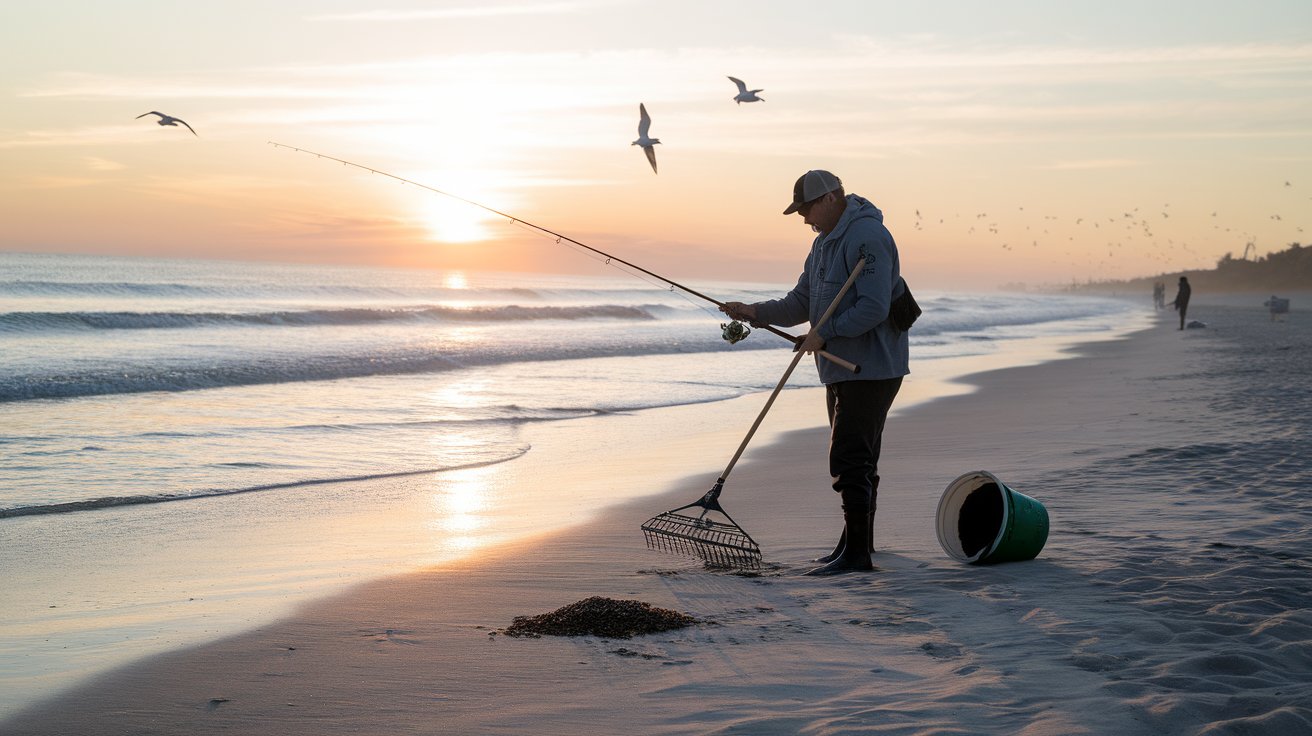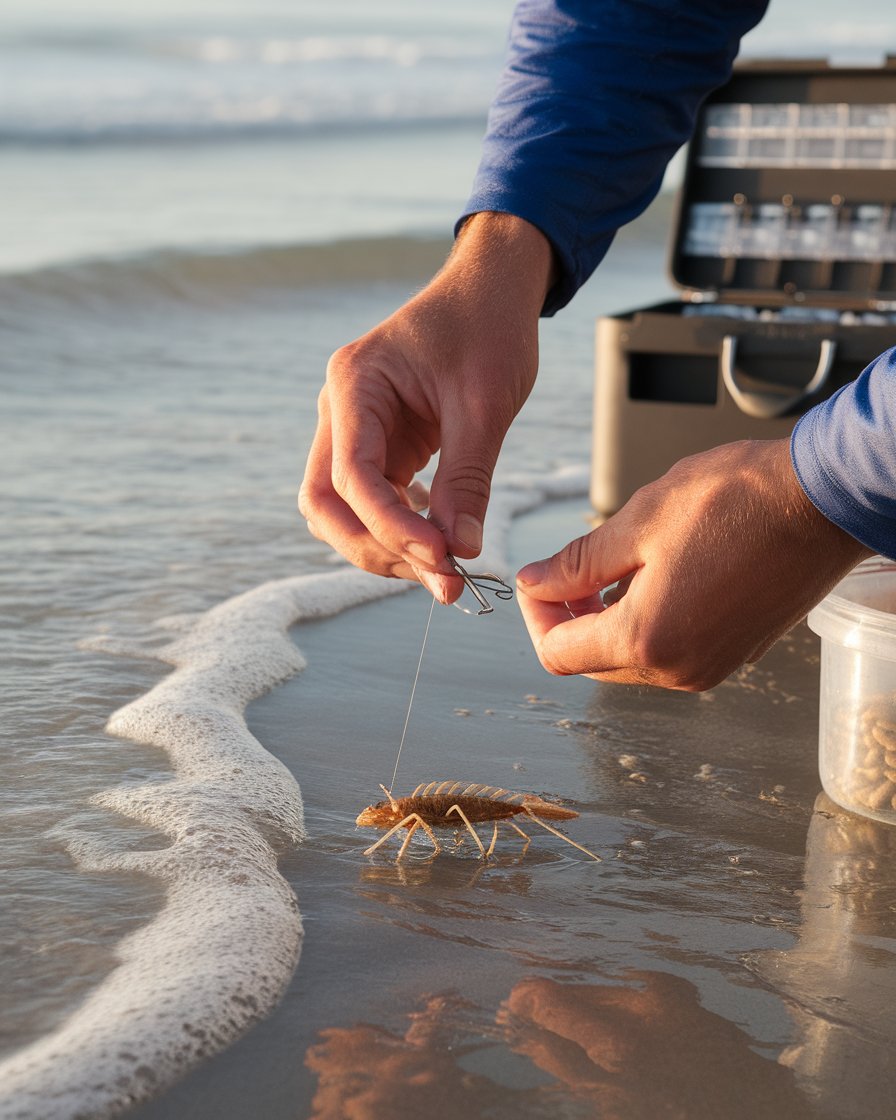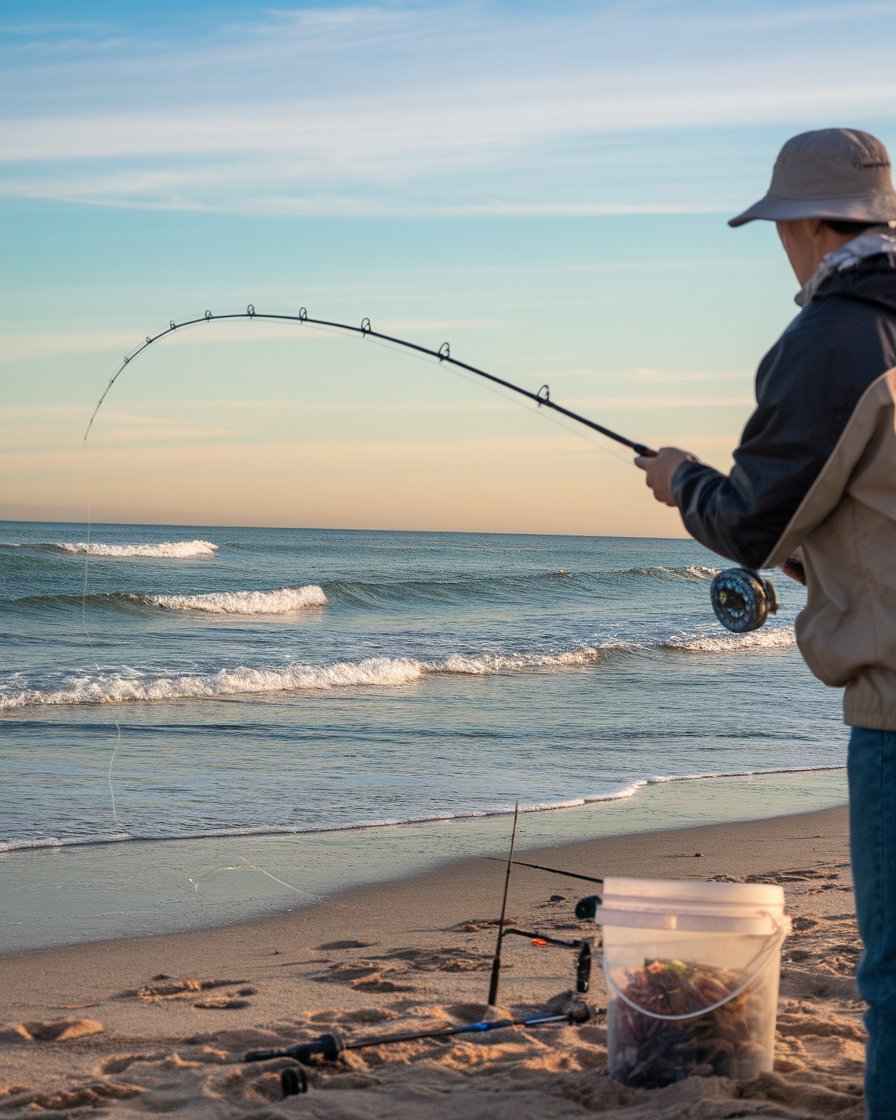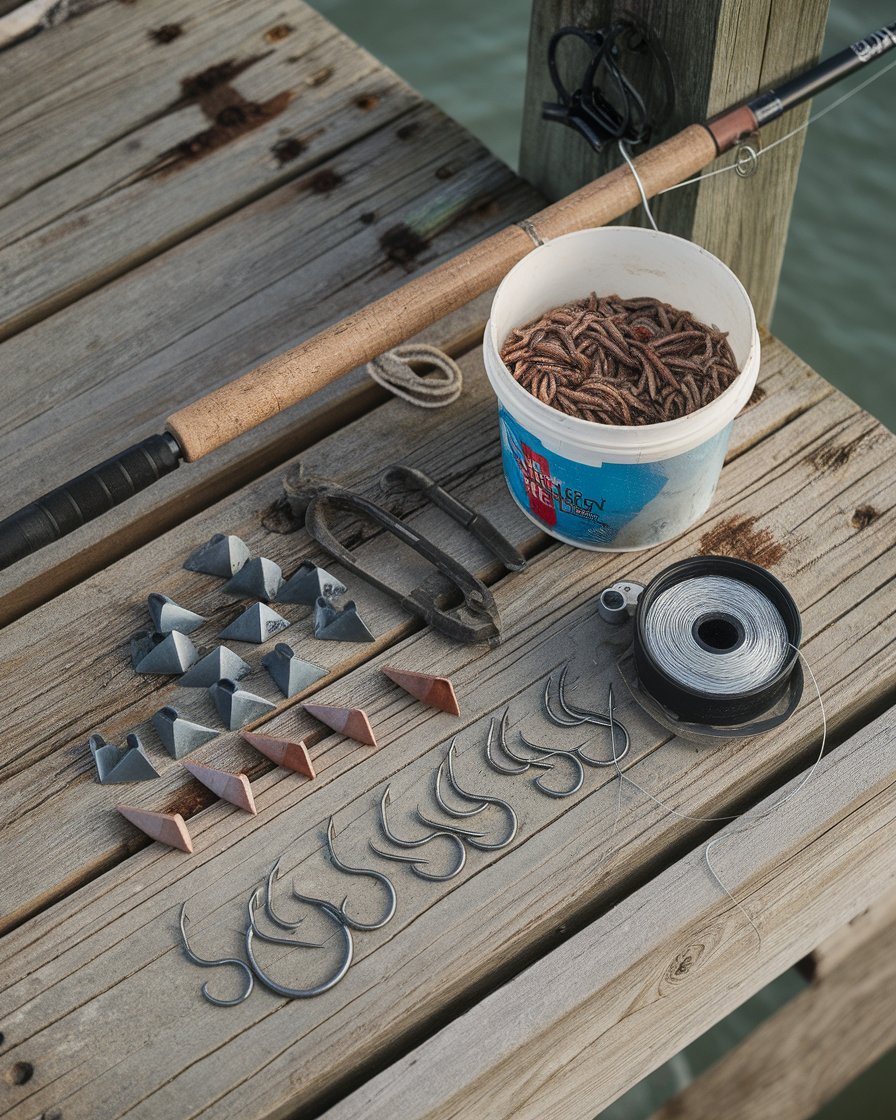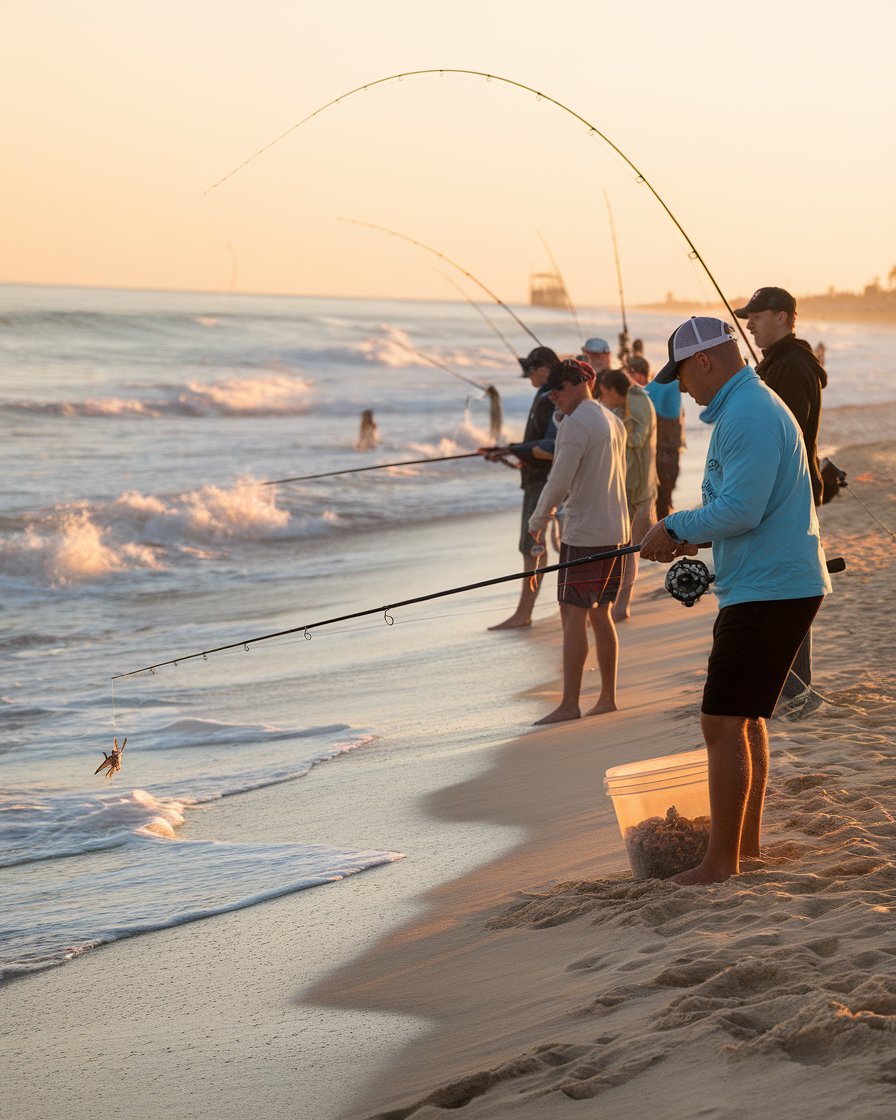Introduction
Sand flea fishing is a popular and effective method for catching a variety of fish species, especially inshore ones like pompano and redfish. These small crustaceans, also known as mole crabs, burrow into the sand along the shoreline, making them a prime bait choice for anglers. By keeping sand fleas alive in a bucket until you’re ready to use them, you preserve their natural scent and movement, which are key factors in attracting fish. Having the right surf fishing gear, such as a sturdy rod, appropriate hooks, and sinkers, will enhance your chances of success.
When preparing for a day outdoors, it’s important to keep the sand fleas lively and use the right rigging techniques. To hook a sand flea correctly, many anglers use light tackle, allowing the bait to move naturally in the water. Using a shovel or sand flea rake helps grab a big handful of sand quickly, ensuring you have everything you need for a productive fishing trip.
Key Takeaways
Sand fleas, also called mole crabs, are excellent bait for catching fish like pompano and redfish along the shoreline.
Properly hooking sand fleas ensures they remain lively, which helps attract fish by mimicking their natural prey.
There are various techniques for hooking sand fleas, with the key being to keep the hook point exposed for better hook sets.
Rigging sand fleas properly keeps them on the ocean floor, increasing the chances of catching fish.
The Carolina and Fish Finder rigs are popular for using sand fleas as bait, helping the flea stay in the strike zone.
Choosing the right hooks, sinkers, and fishing gear is essential for a successful surf fishing trip with sand fleas.
How to Hook Sand Fleas for Fishing
Sand fleas, also known as mole crabs, make excellent bait for a variety of fish, including pompano and redfish. These small crustaceans burrow into the wet sand along the shoreline, making them a prime target for anglers. To catch sand fleas, many fishermen use a sand flea rake to sift through the sand, collecting them for bait. Once caught, hooking them properly is essential for success in saltwater fishing. When hooked correctly, sand fleas stay on the hook longer and mimic the natural prey of the fish, increasing your chances of catching the big one. Mastering this simple technique can improve your surf fishing experience and help you bring in more fish during your next outing.
How to Rig and Hook a Sand Flea Outdoors Fishing Bait
1. Choose the Right Hook Size
Selecting the correct hook size is critical when using sand fleas for bait. The hook should be sized between 2 and 6, depending on the fish you are targeting. A smaller hook helps maintain the natural look of the flea without damaging its body, while a larger hook may work better for bigger fish, such as redfish or pompano.
2. Thread the Hook Properly
For best results, thread the hook through the sand flea’s back, keeping the hook point exposed. This method ensures a better hook set and keeps the flea lively, which will attract fish more effectively. Gently pushing the hook through its shell avoids excessive damage and increases the bait’s longevity in the water.
3. Use a Lightweight Rig
A lightweight rig is ideal for surf fishing with sand fleas. It allows the bait to move naturally in the water, mimicking how sand fleas burrow into the sand. Adding a small weight or sinker keeps the flea in place, while still allowing it to move naturally and attract nearby fish.
4. Keep Sand Fleas Alive Before Use
To maximize the effectiveness of sand fleas, keep them alive in a bucket with seawater until you are ready to fish. The lively movements of a fresh flea are much more attractive to fish compared to a dead one. Regularly refresh the water and keep the bucket in the shade to preserve their liveliness.
5. Target Peak Fishing Times
Maximizing your success with rigged sand fleas involves fishing during peak feeding times, such as early morning or late evening. Fish are more active during these times and more likely to be lured by lively bait. Additionally, target areas with bumps and v-shapes in the sand where fish tend to gather.
Importance of Properly Hooking Sand Fleas
The way you hook sand fleas can make or break your fishing trip. Properly hooking these small crustaceans ensures they remain lively, which helps maintain their natural movements and scent. Fish like redfish and pompano are more likely to be attracted to sand fleas that are hooked in a way that doesn’t damage them, as this keeps their scent intact. Fishermen should aim to hook the sand flea without harming its tail or soft shell. This keeps the flea alive and wiggling, which is irresistible to the fish swimming along the coast. Properly hooked fleas will increase your chances of reeling in a good catch, especially during tide changes when fish are actively feeding.
Techniques for Hooking Sand Fleas
There are different techniques to hook sand fleas, and choosing the right one is key to successful saltwater fishing. One method is to thread the hook through the sand flea’s back, ensuring the barb remains exposed for a better hook set. This technique helps the flea stay attached while mimicking the natural prey of fish like whiting and redfish. Another method involves gently piercing the flea through its soft shell to avoid damaging its body. Depending on the size of your flea and the fish you’re targeting, you’ll want to select the right hook size—usually a kahle hook in the range of 2 to 6. With the right technique, you can keep the flea lively, improving your odds of catching fish along the shoreline.
Rigging Sand Fleas for Fishing Success
When it comes to saltwater fishing, using sand fleas as bait is highly effective, especially for surf fishing. These small crustaceans, which burrow into the wet sand along the beach, are a natural prey for many fish species. To maximize your chances of catching fish, rigging sand fleas properly is essential. A well-rigged sand flea mimics the movements and scent of live prey, attracting fish like pompano and redfish. By securing the flea on the hook and using the correct rigging technique, you can present the bait in a way that keeps it on the ocean floor, right where the fish feed. With the right rig, you’re increasing your odds of a successful day on the beach.
Case Study: Successful Use of Rigged Sand Fleas in Surf Fishing
A 2020 study conducted by recreational fishermen along the Florida Gulf Coast explored the effectiveness of different bait types, including sand fleas for bait. The fishermen focused on surf fishing techniques and compared results using live shrimp, artificial lures, and sand fleas. Over a four-week period, they fished during peak feeding times in sandy, shallow areas known for high fish activity. The study found that sand fleas, especially when rigged using the Carolina rig, significantly outperformed other bait types in attracting species like pompano and redfish.
By threading the hook carefully through the sand flea’s body and adding just the right amount of weight, the bait remained close to the ocean floor, mimicking its natural behavior. The fish were more likely to strike, leading to a higher catch rate of desirable species compared to the other bait types. This case study highlighted how proper rigging and timing can maximize the success of inshore fishing.
Overview of Popular Fishing Rigs for Sand Fleas
Several popular rigs are used by anglers when fishing with sand fleas. One of the most common is the Carolina rig, which is perfect for keeping the bait close to the ocean floor. This rig is favored because it allows the bait to move naturally with the current, mimicking prey in a way that attracts fish. Another popular option is the Fish Finder rig, which offers more versatility and is effective for targeting different fish species along the shoreline. These rigs help ensure that your sand flea stays in the strike zone, making it easier to lure fish from their feeding spots in the waves.
Step-by-step Guide on Rigging Sand Fleas
To rig sand fleas for maximum success, begin by selecting the right hook size, typically between size 2 to 6, depending on the size of the sand flea and the fish you’re targeting. Start by carefully threading the flea onto the hook, ensuring the hook point is exposed to improve hook sets. This helps keep the bait alive and active, increasing its appeal to nearby fish. Attach the rig to your main line, and add a suitable weight to keep the bait in place on the ocean floor. With proper rigging, the sand flea will stay in prime fishing spots, improving your chances of catching fish during your surf fishing outing.
Necessary Gear and Tackle for Sand Flea Fishing
When fishing with sand fleas as bait, having the right gear and tackle can make all the difference. Surf fishing requires specialized equipment to ensure your bait stays in the strike zone and is attractive to the fish you’re targeting. From the fishing rod and reel to the hooks and sinkers, everything needs to work in harmony to increase your chances of a successful catch. Using sand fleas effectively involves understanding how the bait behaves and how your tackle can support its natural presentation. With the right gear, you’ll be better prepared for a productive day at the beach, digging for sand fleas and bringing in your desired fish.
Selecting the Right Fishing Rod and Reel
To get the most out of your sand flea fishing experience, choosing the right rod and reel is essential. For surf fishing, a rod between 9 to 12 feet is ideal for casting far into the ocean, targeting species like pompano or redfish. However, if you’re fishing in areas with more obstacles, like jetties or rocky shorelines, a shorter rod of about 7 to 9 feet might be more practical. Pairing your rod with a durable, saltwater-resistant reel ensures that you’re ready to handle the challenges of surf fishing. Proper gear makes it easier to dig into the sand, cast efficiently, and reel in a great catch.
Choosing the Appropriate Hooks and Sinkers
Selecting the right hooks and sinkers is just as important as your rod and reel when fishing with sand fleas. Hooks in sizes 2 to 6 work best for securing sand fleas without damaging them. This allows them to remain lively, attracting fish more effectively. For sinkers, pyramid or egg sinkers are the go-to choice, as they provide the stability needed in sandy bottoms and moderate waves. The right combination of hooks and sinkers ensures that your bait stays put and in the strike zone, increasing your odds of success. Equipped with the proper tackle, you’re set for a rewarding day of surf fishing.
“Fishing is much more than fish. It is the great occasion when we may return to the fine simplicity of our forefathers.” – Herbert Hoover
Tips and Tricks for Effective Sand Flea Fishing
Sand flea fishing can be a rewarding experience for anglers, but getting the most out of your bait requires a few smart tactics. Using fresh sand fleas and the right fishing techniques can greatly improve your chances of a successful catch. Sand fleas, known for their natural movement and strong scent, are a favorite prey for many species of fish. To make the most of them, it’s important to handle them properly and use the correct rigging to keep them lively and attractive in the water. With some simple adjustments, you can turn an average day of surf fishing into a highly productive one.
Maximizing the Attractiveness of Sand Fleas as Bait
To maximize the appeal of sand fleas, keeping them alive until you’re ready to fish is essential. Using a bait bucket with a bit of ocean water ensures they stay fresh and active, retaining their natural scent. Fish, especially inshore species, are drawn to the movement and scent of live sand fleas. Additionally, a lightly weighted rig will allow the fleas to move naturally in the surf, mimicking how they burrow into the sand when disturbed. This realistic movement increases the chances of enticing fish like pompano or redfish. The fresher the bait, the better your odds of catching fish along the shoreline.
Strategic Approaches for Landing Fish with Rigged Sand Fleas
When using rigged sand fleas, timing and location are everything. Fishing during peak feeding times—early in the morning or late in the evening—will increase your chances of success. These are the times when fish are actively searching for food along the shore. It’s also wise to target areas with natural structure, such as jetties or sandy bars, where fish often gather. Patience is key in surf fishing, so don’t hesitate to adjust your approach throughout the day. With persistence and the right strategy, your rigged sand fleas can help you reel in a great catch.
Conclusion
Sand flea fishing is a great way to hook inshore species like pompano and redfish, especially when you use sand fleas for bait. These little creatures, also known as mole crabs, make excellent bait because they burrow into the sand, just where fish love to feed. Keep your sand fleas fresh by storing them in a bucket with some seawater—this helps maintain their scent and movement, making them irresistible to fish. To have the best fishing experience, it’s all about having the right tools—your rod, sinkers, and hooks all need to work together.
When it comes to catching fish with sand fleas, timing is everything. Early morning or evening is when fish are most active. Also, look for bumps and v-shapes in the sand—those are key spots where fish tend to gather. Using a jig or monofilament line will keep your bait looking natural in the water. Remember, patience is key, but with fresh bait, the right surf fishing gear, and a little persistence, you’ll likely enjoy a successful day on the shore.

